
However, when inventory and other assets are involved, it is essential to apply the latest inventory cost methods, such as FIFO or LIFO, waiting on the broader harmonization under IFRS reviews. In scenarios where a separate Dividends account has been in use during the period, this temporary account is swept clean at year-end. According to best practices outlined on learning platforms including Investopedia, the balance is moved to Retained Earnings, reducing the account by the total dividends paid. This vital adjustment reflects the accrual accounting’s core principle of accurately recording transactions, maintaining the integrity of the closing entries process.
- By closing out revenue and expense accounts, they prep the books for the new accounting period, making sure you’re not mixing scenes from two different plays.
- Start by debiting each revenue account for its total balance, effectively reducing the balance to zero.
- A sole proprietor or partnership often uses a separate drawings account to record withdrawals of cash by the owners.
- Temporary accounts are used to record accounting activity during a specific period.
- The next step is to repeat the same process for your business’s expenses.
What are Temporary Accounts?
A term often used for closing entries is “reconciling” the company’s accounts. Accountants perform closing entries to return the revenue, expense, and drawing temporary account balances to zero in preparation for the new accounting period. If the income summary account has a debit balance, it means the business has suffered a loss during the period and decreased its retained earnings.
Frasker Corp. Closing Entries
Grasping the difference between temporary and permanent accounts is key to understanding the accounting cycle. Temporary accounts are like gusts of wind, present only for a season. They include revenues, expenses, and dividends, and their purpose is to track the financial comings and goings within a specific period.
Introduction to the Closing Entries
This is crucial because it clears out last year’s earnings, so you can accurately track how much you earn next year without any confusion from past amounts. We follow strict ethical journalism practices, which includes presenting unbiased information and citing reliable, attributed resources. Our team of reviewers are established professionals with decades of experience in areas of personal finance and hold many advanced degrees and certifications. For information pertaining to the registration status of 11 Financial, please contact the state securities regulators for those states in which 11 Financial maintains a registration filing.
- In this context, a well-maintained FAQ section can be a valuable resource for those new to these concepts, ensuring they understand the impact of these transactions on owner’s equity.
- At the end of the accounting year 2018, the expense account needs to be credited to clear its balances, and the Income summary account should be debited.
- For the past 52 years, Harold Averkamp (CPA, MBA) has worked as an accounting supervisor, manager, consultant, university instructor, and innovator in teaching accounting online.
- As we mentioned, the income summary is a temporary account in itself.
- One such expense that’s determined at the end of the year is dividends.
- With the use of modern accounting software, this process often takes place automatically.
Now, it’s time to close the income summary to the retained earnings (since we’re dealing unearned revenue with a company, not a small business or sole proprietorship). Expense accounts have a debit balance, so you’ll have to credit their respective balances and debit income summary in order to close them. As mentioned, one way to make closing entries is by directly closing the temporary balances to the equity or retained earnings account. Temporary accounts can either be closed directly to the retained earnings account or to an intermediate account called the income summary account.

By leveraging advanced workflow management, the no-code platform, LiveCube ensures that all closing tasks are completed on time closing entries and accurately, reducing the manual effort and the risk of errors. Organizations can achieve a 40% increase in close productivity, resulting in a more streamlined financial close process and allowing your team to focus on more strategic activities. Once we have obtained the opening trial balance, the next step is to identify errors if any, make adjusting entries, and generate an adjusted trial balance. Well, dividends are not part of the income statement because they are not considered an operating expense. In other words, they represent the long-standing finances of your business.
Process of preparing closing entries

First, all the various revenue account balances are transferred to the temporary income summary account. https://www.bookstime.com/ This is done through a journal entry that debits revenue accounts and credits the income summary. Closing your accounting books consists of making closing entries to transfer temporary account balances into the business’ permanent accounts. Remember the income statement is like a moving picture of a business, reporting revenues and expenses for a period of time (usually a year). We want income statements to start every year from zero, but for accounts like equipment, debt, and cash accounts—reported on the balance sheet—we want to keep a running balance from the beginning of the business.

It can be a calendar year for one business while another business might use a fiscal quarter. Income and expenses are closed to a temporary clearing account, usually Income Summary. Afterwards, withdrawal or dividend accounts are also closed to the capital account. To close the drawing account to the capital account, we credit the drawing account and debit the capital account.
- Programs like QuickBooks and Xero automate the steps, ensuring accuracy and consistency, which saves time and reduces human error.
- ABC Ltd. earned ₹ 1,00,00,000 from sales revenue over the year 2018 so the revenue account has been credited throughout the year.
- The process of using of the income summary account is shown in the diagram below.
- In a general financial accounting system, temporary or nominal accounts include revenue, expense, dividend, and income summary accounts.
- Now, all the temporary accounts have their respective figures allocated, showcasing the revenue the bakery has generated, the expenses it has incurred, and the dividends declared throughout the past year.
- Whether it’s a routine audit or a surprise check from the authorities, with accurate closing entries, you’ll have nothing to fear.
Journalizing and Posting Closing Entries

The accounts that need to start with a clean or $0 balance goinginto the next accounting period are revenue, income, and anydividends from January 2019. To determine the income (profit orloss) from the month of January, the store needs to close theincome statement information from January 2019. Temporary accounts are income statement accounts that are used to track accounting activity during an accounting period.
